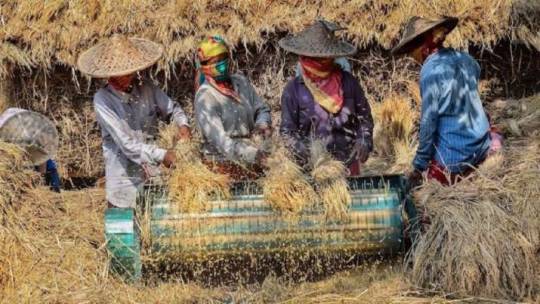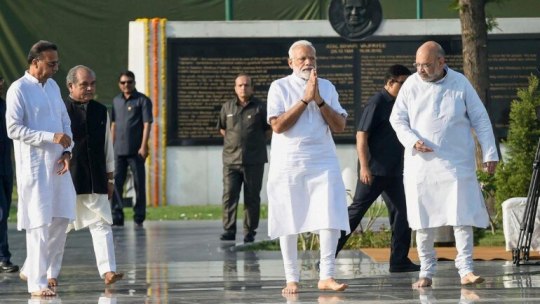#dbt pm kisan:
Text
प्रधानमंत्री किसान खाद योजना(DBT Schemes)2023
2 notes
·
View notes
Text
BUDGET
Budget and its importance
Budget is a financial plan that outlines an organisation’s or an individual’s estimated revenues and expenses over a specific period of time. It serves as a roadmap for managing financial resources and achieving financial goals. Budget can cover various time frames, such as monthly, quarterly, or annually, and they are crucial tools for effective financial management.
Importance of Budget
Financial Planning: Budgets help individuals and organisations plan and allocate resources effectively. They provide a framework for setting financial goals and working towards them.
Resource Allocation: By outlining expected revenues and expenses, budgets help in allocating resources efficiently, ensuring that funds are directed to the most critical areas.
Decision- Making: Budget assists in decision-making processes by providing a financial perspective. They help in evaluating the financial feasibility of different options and choosing the most viable ones.
When Budget implemented in India
The implementation of the budget in India can be traced back to the colonial period. The British introduced budgetary practices in India, and the first budget of India was presented by James Wilson, the Finance Member of the India council, in 1860. This marked the formal beginning of the budgetary process in India during British rule.
The first budget in India was presented on february 18, 1860, by James Wilson. At that time, James Wilson served as the Finance Member of the India Council, Which was part of the British colonial administration. This event marked the formal beginning of the budgetary process in India during British rule.
NITI Aayog
NITI Aayog, or the National Institution for Transforming India, is a policy think tank of the government of India. It was established on January 1, 2015, to replace the planning commission, which had been in existence since 1950. The formation of NITI Aayog marked a significant shift in the approach to economic planning and policy-making in India. It focuses on a more dynamic and cooperative approach to development planning and policy formulation. It aims to align the diverse interests of states and union territories, fostering a more inclusive and collaborative model of governance.
Budget before and after 2014
The budget before 2014 refers to the period when the united Progressive Alliance (UPA) government, led by the Indian Congress, was in power. The UPA government presented its last full-year budget for the fiscal year 2013-2014. During this period, there were concerns about fiscal deficits, inflation, and economic growth. The budgetary allocations were influenced by the global economic situation and domestic challenges.
After 2014, the National Democratic Alliance(NDA) government, led by the Bharatiya Janata Party(BJP), came to power. Arun Jaitley served as the Finance Minister in the initial years. The budgets presented during this period focused on economic reforms, fiscal consolidation, and boosting infrastructure. The government implemented initiatives such as the goods and services tax (GST) and made efforts to foreign investment.
Highlights of budget 2024
The financial management announced that the same tax rates will be retained inFY 2024-25 for direct taxes. There will be no tax liability for taxpayers with an income of up to Rs. 7 lakh, under the new tax regime.
The FM announced that the average monthly gross GST collection has doubled to 1.66 lakh crore in FY24.
There will be substantive development of all forms of infrastructure, physical, digital and social.
Direct Benefit Transfer (DBT) has led to savings of Rs. 2.7 lakh crore.
1.4 crore youth have been trained under the skill India Mission.
There has been direct financial assistance provided to 11.8 crore farmers under PM-KISAN.
30 crore Mudra Yojana loans have been disbursed to women entrepreneurs.
0 notes
Text
Interim Budget 2024-25, a beacon of hope for India's growth amid challenges

The Interim Budget 2024-25, presented by Union Finance and Corporate Affairs Minister Nirmala Sitharaman seeks to inject the economy with policies and measures aimed at reigniting positive sentiments and accelerating growth. Can this budget be the catalyst for achieving these growth targets? Let’s delve into its key highlights.
Under the guiding principles of ‘Sabka Saath, Sabka Vikas, and Sabka Vishwas’ and the inclusive approach of “Sabka Prayas,” the Finance Minister presented the Interim Union Budget 2024-25 in Parliament. The budget focuses on social justice, particularly uplifting four major segments: the poor (‘Garib’), women (‘Mahilayen’), youth (‘Yuva’), and farmers (‘Annadata’).
Key Initiatives:
Poverty Alleviation: The budget emphasises 'Garib Kalyan, Desh ka Kalyan,' claiming to have lifted 25 crore people out of multi-dimensional poverty in the last decade. Direct Benefit Transfer (DBT) of Rs 34 lakh crore through PM-Jan Dhan accounts has resulted in government savings of Rs 2.7 lakh crore. The PM-SVANidhi scheme provided credit assistance to 78 lakh street vendors, with 2.3 lakh receiving credit for the third time.
Tribal and Artisan Support: Schemes like PM-JANMAN Yojana aid the development of particularly vulnerable tribal groups (PVTG), while PM-Vishwakarma Yojana provides end-to-end support to artisans and craftspeople in 18 trades.
Agricultural Initiatives: PM-KISAN SAMMAN Yojana provided financial assistance to 11.8 crore farmers, while PM Fasal Bima Yojana offers crop insurance to 4 crore farmers. The Electronic National Agriculture Market (e-NAM) integrated 1361 mandis, serving 1.8 crore farmers with a trading volume of Rs 3 lakh crore.
Women Empowerment: The budget highlights 30 crore Mudra Yojana loans given to women entrepreneurs. Female enrollment in higher education has increased by 28%, with girls and women constituting 43% of enrollment in STEM courses, one of the highest rates globally. Over 70% of houses under PM Awas Yojana in rural areas have been allotted to women.
Housing: Despite COVID challenges, the budget aims to achieve the target of three crore houses under PM Awas Yojana (Grameen) soon, with an additional two crore houses to be taken up in the next five years.
Strategic Initiatives:
Rooftop Solarisation and Free Electricity: A significant announcement is the provision of 300 units of free electricity per month through rooftop solarisation to one crore households, expected to save households Rs 15,000 to Rs 18,000 annually.
Healthcare: The Ayushman Bharat scheme will be extended to all Accredited Social Health Activist (ASHA) workers, Anganwadi Workers, and Helpers, ensuring broader access to healthcare services.
Agriculture and Food Processing: The Pradhan Mantri Kisan Sampada Yojana has benefited 38 lakh farmers and generated 10 lakh employment opportunities. The Pradhan Mantri Formalisation of Micro Food Processing Enterprises Yojana has assisted 2.4 lakh Self-Help Groups (SHGs) and 60,000 individuals with credit linkages, boosting the agricultural and food processing sectors.
Research and Innovation: A corpus of Rs 1 lakh crore will be established with a fifty-year interest-free loan to catalyse growth, employment, and development through research and innovation.
Infrastructure: An 11.1% increase in capital expenditure outlay for infrastructure development and employment generation, amounting to Rs 11,11,111 crore, is aimed at enhancing the country's infrastructure and creating employment opportunities.
Railways: Under the PM Gati Shakti initiative, three major economic railway corridor programs will be implemented to improve logistics efficiency and reduce costs.
Aviation Sector: The plan to double the number of airports to 149 and the order of over 1000 new aircraft signals significant growth in the aviation sector.
Green Energy: Plans include setting up a coal gasification and liquefaction capacity of 100 MT by 2030 and a phased mandatory blending of compressed biogas (CBG) in compressed natural gas (CNG) for transport and piped natural gas (PNG) for domestic purposes.
Tourism Sector: States will be encouraged to undertake comprehensive development of iconic tourist centers, with long-term interest-free loans provided for financing such development.
Investments: The budget highlights significant Foreign Direct Investment (FDI) inflows, totaling USD 596 billion during 2014-23, reflecting a positive outlook for investments in the country.
Reforms in the States: To support milestone-linked reforms by state governments, a provision of Rs 75,000 crore as a fifty-year interest-free loan is proposed.
The budget also focuses on tax rationalisation efforts, achievements in taxpayer services, and the economic journey since 2014. It sets the stage for a dynamic and inclusive growth trajectory, aiming to propel India towards greater prosperity and well-being for all its citizens.
Read the full article
0 notes
Text
PM Kisan 15th installment released: eKYC mandatory by Jan 31 to get next payment
The 15th installment of PM Kisan scheme was released on Nov 15, 2023. eKYC mandatory for registered farmers by Jan 31, 2024 to receive next payment. If not completed by January 31, 2024, farmers may become ineligible for next installment.
PM Kisan 15th installment, released on Nov 15, 2023:
PM Kisan is a central government scheme, that provides income assistance of Rs 6000 annually to eligible land-holding farmer households in three equal payments, and the funds will be instantly deposited into their bank accounts. The 15th installment of PM Kisan was released on November 15, 2023.
PM Kisan e-KYC, mandatory for Registered farmers:
As per the PM Kisan website, “e-KYC is compulsory for PM Kisan registered farmers. OTP-based and biometric-based e-KYC options available on the PM Kisan portal or nearest CSC centers.”
If e-KYC is not completed, beneficiary farmers may not receive the instalment.
Farmers become ineligible if the e-KYC process is not done by Jan 31:
As per the Agriculture Rajasthan website, 39580 farmers in the district have not completed e-KYC, Aadhaar seeding of 11566 farmers, and land verification of 24007 farmers is yet to be done. All these should be completed soon, or else the eligible farmers will not get the benefit of the next installment. The farmers become ineligible if they do not complete the e-KYC process of PM Kisan by January 31.
District Collector's Warning:
Rohitashv Singh Tomar, District Collector said, that the farmers, who fail to complete the e-KYC process by January 31, will not receive the next installment. The farmer’s account can become inactive and DBT can be stopped, if the farmers do not complete the land seeding process as well.
Get the land details verified:
To get their land details verified, the beneficiaries are required to present the specific documents including the list number, registration number, and mobile number at the relevant Patwari Halka or Tehsil office.
eKYC – How to get it done?
Farmers can complete the e-KYC process through thumb impression at their nearest e-Mitra or CSC center. Face authentication is another method to do the e-KYC process – it can be done by downloading the PM Kisan GOI app.
Farmers can get the e-KYC done by linking their bank account with Aadhaar and also by linking DBT to open an account via India Post Bank apart from bank
eKYC – Why it is needed?
To make sure that the PM Kisan scheme benefit reaches all the beneficiaries in their Aadhaar-seeded bank accounts.
eKYC Modes:
Moreover, three modes of eKYC are available to the farmers under the PM-Kisan scheme:
1. OTP-based e-KYC process, available on PM-Kisan Portal and Mobile App
2. Biometric-based e-KYC process, available at Common Service Centres (CSC), and State Seva Kendra (SSK)
3. Face authentication-based e-KYC process, available on the PM-Kisan Mobile app
How OTP based e-KYC can be done?
For OTP-based eKYC, it is necessary for a farmer to have an Aadhaar linked to their active mobile number. Follow the given steps to get it done
Step 1: Visit the PM Kisan portal https://pmkisan.gov.in/
Step 2: Click on e-KYC
Step 3: Enter your Aadhaar number and complete your eKYC process by submitting your OTP.
Biometric-based e-KYC:
Biometric-based e-KYC is made available to more than 4 lakh CSCs and other SSKs throughout the country, to provide convenient services to the farmers.
Visit your nearest CSC or SSK along with your Aadhaar Card and the mobile number linked with Aadhaar. The CSC or SSK operator will help the farmer perform the biometric authentication process
Face-authentication e-KYC:
Face-authentication is the most effective and hassle-free method of doing e-KYC, which can be done by the farmers at their own convenience
Step 1: From the Google Play Store, download the PM-Kisan mobile app and Aadhaar Face RD app
Step 2: Open the app and log through the registered mobile number with PM-Kisan
Step 3: Go to the beneficiary status page
Step 4: If the e-KYC status is "No", click on the eKYC, then enter your Aadhaar information
Step 5: Give your consent to scan your face
Step 6: After scanning your face successfully, e-KYC is done.
Note: The e-KYC status will be reflected in the beneficiary status only after 24 hours in all modes.
0 notes
Text
PM Kisan : आ गई डेट, जानिए किस दिन जारी होगी पीएम किसान की 14वीं किस्त, PM Kisan 14th Installment Date 2023
PM Kisan 14th Installment Date 27 july 2023 को देश के हर किसान के खाते मैं आ जाएगी देश में चल रही लाभ और कल्याणकारी योजनाओं से गरीबों और जरूरतमंदों तक लाभ पहुंचाया जा रहा है।
PM श्री Narendramodi जी, 27 जुलाई 2023, प्रातः 11:00 बजे, सीकर राजस्थान में PMKisanSammanNidhi के तहत 8.5 करोड़ से अधिक लाभार्थी किसान परिवारों को 14वीं किस्त DBT के माध्यम से हस्तांतरित करेंगे.
जैसे- किसानों के लिए (PM…

View On WordPress
#PM Kisan 14th Installment#pm kisan 14th installment date 2023#pm kisan 14th installment date 2023 in hindi#pm kisan samman nidhi 14 kist#Pm kisan Samman Nidhi Yojana Helpline Number#pm kisan status check aadhar card#pm kisan status kyc#pm kisan.gov.in registration#pmkisan#पीएम किसान की चौथी किस्त कब आएगी#पीएम किसान सम्मान निधि योजना 2023 लिस्ट
0 notes
Text
0 notes
Text
PM Kisan: The wait of the farmers will end soon, when will they get Rs 2000 in their account? Know here the latest updates on the 14th installment
Actually, PM Kisan Samman Nidhi Yojana is a big scheme of the Central Government, it was started by the Central Government on December 1, 2018. Under this, 6000 rupees are given annually to the farmers by the government in 3 installments. 2000-2000 rupees are transferred to the accounts of the farmers every 4 months. This money directly reaches the farmers’ account through DBT transfer.
PM Kisan…

View On WordPress
0 notes
Link

This blog launched on 17 july, 2015 for share useful and helpful content for beginners. This is multi-author blog and you can learn something new everyday with fresh article.
CSCLOGIN
0 notes
Text
PM Modi Releases Over Rs 16,000 Cr Under PM-Kisan Yojana To 8 Cr Beneficiary Farmers; Here’s How To Check Your Intallment Status
It is expected that over 8 crore farmers will be benefited under PM-Kisan Yojana. All of them will receive the money in their accounts under direct benefit transfer (DBT).
source https://zeenews.india.com/personal-finance/pm-modi-releases-over-rs-16000-cr-under-pm-kisan-yojana-to-8-cr-beneficiary-farmers-here-s-how-to-check-your-intallment-status-2577731.html
View On WordPress
0 notes
Text
पीएम मोदी ने जारी की पीएम किसान की 12वीं क़िस्त, 8 करोड़ से अधिक किसानों के खाते में भेजे 16 हजार करोड़ रुपये
PM kisan 12th installment released Today 17 October 2022 : आज प्रधानमंत्री नरेंद्र मोदी ने पीएम किसान सम्मान निधि की 12वीं किस्त जारी की. प्रधानमंत्री नरेंद्र मोदी (PM Narendra Modi) ने सोमवार को 8 करोड़ से अधिक लाभार्थी किसान परिवारों को 16,000 करोड़ रुपये से अधिक की सम्मान निधि राशि DBT के माध्यम से उनके बैंक खातों में ट्रांसफर कर दी है.
पीएम मोदी ने आज सोमवार 17 अक्टूबर को भारतीय कृषि…

View On WordPress
0 notes
Link
0 notes
Text
Budget 2021: Govt should provide additional funds, incentives for agri sector, say experts
Budget 2021: Govt should provide additional funds, incentives for agri sector, say experts
Image Source : PTI
Budget 2021: Govt should provide additional funds, incentives for agri sector, say experts
The government should provide additional funds as well as incentives in the upcoming Budget to promote indigenous farm research, oilseeds production, food processing and organic farming for the overall growth of the agriculture sector, according to industry experts.
The direct benefit…

View On WordPress
#BKS#budget#Budget 2021#Budget 2021-22#DBT#deloitte india#Finance Ministry#pm kisan#Union Budget 2021
0 notes
Text
Government ends up paying Rs 1364 cr to undeserving beneficiaries under the PM – KISAN, according to RTI data; reminisce to the Aadhar linked Direct Benefit Transfer Schemes that benefitted the nexus between bank officials and the state government employees?
Government ends up paying Rs 1364 cr to undeserving beneficiaries under the PM – KISAN, according to RTI data; reminisce to the Aadhar linked Direct Benefit Transfer Schemes that benefitted the nexus between bank officials and the state government employees?
While the farmers’ protest in Delhi takes a more robust hue as both concerned parties, the farmers and the Union government, refuse to give in, the Union government faces some embarrassment since it has ended up paying Rs 1,364 crore to undeserving beneficiaries under the PM – KISAN scheme.
According to the data released by RTI sought from the Union Agriculture Ministry has revealed that under…

View On WordPress
0 notes
Text
PM Kisan releases 7th installment of Kisan Samman Fund, check it online
PM Kisan releases 7th installment of Kisan Samman Fund, check it online
पीएम किसान सम्मान निधि की सातवीं किस्त जारी, ऑनलाइन ऐसे चेक करें
The seventh installment of pm kisan samman fund has been released on Friday. In this scheme, the government deposits Rs 6,000 per year in farmers’ bank accounts.
Prime Minister Narendra Modi released the seventh installment of the PM Kisan Samman Fund on Friday (December 25). He transferred Rs 18,000 crore online to…

View On WordPress
#DBT#Keyword#PM Kisan#Upagriculture#किसान मोबाइल एप#किसान सम्मान निधि का पैसा#किसान सम्मान निधि केसीसी#किसान सम्मान निधि योजना पंजीकरण#किसान सम्मान निधि योजना बिहार#किसान सम्मान निधि योजना हेल्पलाइन नंबर#किसान सम्मान निधि शिकायत#केसीसी लिस्ट कैसे देखें#पिय किसान#पीएम किसान एप#प्रधानमंत्री किसान योजना 6000 वाली#प्रधानमंत्री किसान सम्मान निधि योजना लिस्ट
0 notes
Photo

PM-किसान सम्मान निधि स्कीम: 3.78 करोड़ किसानों के बैंक अकाउंट में भेजे गए 10-10 हजार रुपये नई दिल्ली. मोदी सरकार ने देश के 3.78 करोड़ किसान परिवारों को खेती-किसानी के लिए उनके बैंक अकाउंट में अब तक 10-10 हजार रुपये की सहायता राशि डाल दी है.
#Aadhaar card#bank account#DBT#farmers#KISAN Help Desk#ministry of agriculture#PM Kisan Samman Nidhi Scheme#PM-Kisan#PM-Kisan scheme 5th Installment#किसान#किसान हेल्प डेस्क#कृषि मंत्रालय#डायरेक्ट बेनिफिट ट्रांसफर#पीएम किसान योजना की पांचवीं किश्त#पीएम-किसान#पीएम-किसान सम्मान निधि स्कीम#बैंक अकाउंट
0 notes